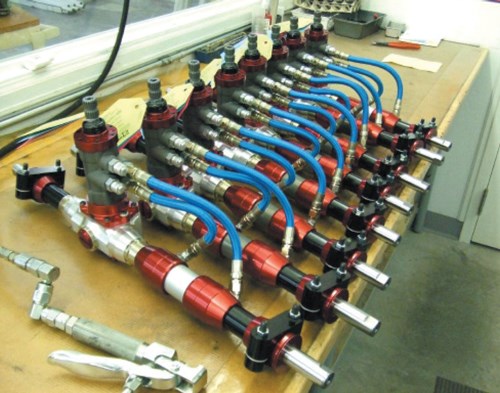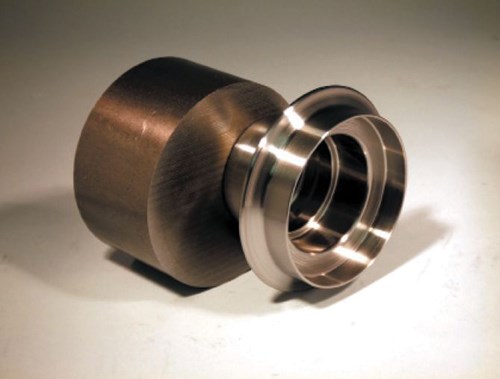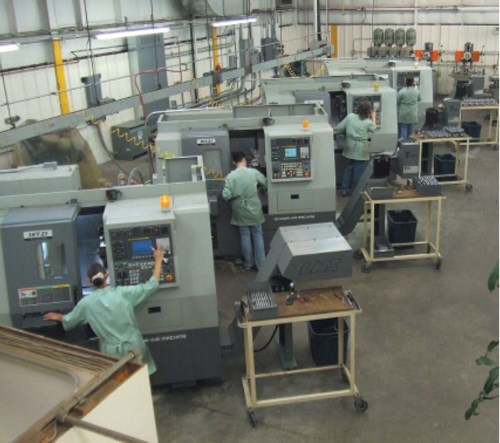Racing to High Tech Turning
A manufacturer of race car components gets higher RPM, quicker rapids and a sophisticated control with a new lineup of turning machines.
Little significance is given by most to the manufacturing origin of race car steering components. Still, Wyoming—the land of boom-and-bust energy towns, cowboys, cattle skulls, tumbleweed and sagebrush—hardly leaps to mind during conversations of NASCAR, Australian V8 Supercars or Formula Le Mans racing. But that’s where at least one key supplier to these series has set up shop.
Tony Woodward founded Woodward Machine Corporation in 1978 in a Maryland/Washington D.C. suburb as a job shop specializing in race car fabrication and general repair. Near the beginning of the 80s, he dreamed up a rack and pinion steering system for dirt track stock cars and started producing it on manual equipment, mostly rebuilt and salvaged from scrap yards. The only new machine in the shop was a Bridgeport.
By 1984 the company had shop-built a lot of single-purpose machines, and the castings were being walked through a sort of poor man’s transfer line. It actually made sense to do it that way because the castings were magnesium, and cutting magnesium in an enclosed machining center with water-based coolant is a well-known fire hazard. However, operators had to continually sweep up and dispose of the magnesium chips, and that alone became a huge time waste.
During the next several years, the company added many new products—mostly turned workpieces—to its line of steering components, becoming even more dependent on manual machines and experienced machinists. Woodward was attached to the old processes, but it began to struggle because the labor-intensive technology of 1935 had its limits. In 1991, the company purchased a used Ikegai FX20N turning center, which contributed on round parts. Mr. Woodward spent months learning CNC programming from the Fanuc manuals, but finally reached a defining moment one evening while eating takeout with his wife Gloria while the machine made parts all by itself.
“We knew that from then on we would be transitioning the company to CNC,” Mr. Woodward says. “Initially through used machines, but ultimately through the newest technology applicable to our products.” Eventually the company’s adoption of CNC led to abandoning magnesium castings in favor of aluminum, and later acquiring a stable of Hyundai WIA turning machines.
The Shop
The facility is 15,000 square feet, 12,000 of which are used as production floor. It has been expanded several times since relocating to Casper, Wyo., in 1993, and each expansion has been financed directly from earnings. The original 5,000-square-foot building already had 480-volt, three-phase and overhead busways. Woodward has a staff of ten—for the most part single moms who have retrained for careers in
industry.
Products are race car steering components, including gears, racks, needle bearing universal joints, collapsible safety steering columns and steering wheel quick releases. In-car camera shots during any NASCAR event reveal the Woodward logo. The company manufactures its own hydraulic power steering system in-house, including the hypersensitive directional control valve. Virtually all other systems marketed for racing utilize OEM valve components; Woodward is one of relatively few companies in the world that actually makes those parts. The company has a distributor for its racing products in the EU, a growth market for Woodward’s precision steering products.
Materials
Gears and valve components are machined from 41L42 and 41L50. Typical part size is from ¾ inch up through 1-5/8 inches diameter by as much as 6 inches long.
“Although we eventually grind these parts to size after hardening, some of them require intermediate operations such as hobbing and milling that absolutely must start with an accurately turned and centered workpiece,” says Mr. Woodward. Almost all of the parts need to be held within 0.001 inch on the diameter right from the first operation. “We do all our turning with cermet inserts, and we find that with the Hyundai WIAs, we can run near the upper limit of SFM, which is where those inserts really shine. The harder grades of cermet are vulnerable to thermal shock, so we turn steel dry.”
Woodward also makes a lot of commodity parts that many other companies would farm out, such as crimp-style hydraulic hose ends and various non-heat-treated fasteners and other hardware. The material for these ranges from 12L14 up through ETD 150, in diameters as large as 2 inches.
“ETD 150 is a trademark material of the LaSalle Steel Company, which patented the process,” Mr. Woodward says. It’s basically a 4142 that has been drawn through dies at an elevated temperature, not as high as normal forging temperature, but just high enough to allow the material to be reduced in cross section by two-thirds in one pass. The result is a material that, from this plastic deformation, has an almost uniform hardness from the outside to the inside.
“Many of our bulkier race car parts are aluminum,” Mr. Woodward says. “On our older, slower turning centers, it was sometimes necessary to use an expensive, free-machining grade such as 2011, but with the RPM capability of the Hyundai WIAs, we’ve been able to use 6061, which is better for color anodizing, not to mention lower cost.”
Taking on Tough Work
A typical part at Woodward is a 3-inch diameter steel part turned from a slug—the pull ring for a NASCAR steering wheel quick release unit. It’s quite thin, with less than 5 percent of the material left after machining. “For an old lathe hand like me, there are few things more satisfying than being able to rip steel off to the absolute limits of the holding power of the chuck, without chatter and without compromising the finish or accuracy. The Hyundai WIAs will do that, in spades,” Mr. Woodward says.
For bar work, the operators change out liner bushings and chuck jaws, download the program, touch off the tools, graph it and go. For second operations, they’ll rebore the jaws first. In the interest of speed, Mr. Woodward doesn’t get too upset if a few parts are sacrificed while fine-tuning the offsets, at least in the initial stages of the part. In a job shop it would be different, but here, if they get 495 first-operation parts instead of 500, it doesn’t matter.
“We view these newer Hyundai WIA machines as replacements for our older turning centers, giving us higher RPM, quicker rapids and a sophisticated control. Around 2006, it came time to replace our existing equipment, and we evaluated everything on the market for bar capacity, RPM and rapid traverse speed. It seemed to me, 4,000 rpm with a 2 ½-inch bar capacity was pretty far beyond anything made in the U.S., and for all I know it still is, so the advertised specs for the Hyundai Kia SKT-21 (currently known as the Hyundai WIA L210) frankly didn’t sound real, especially not for the price. So we visited a shop that was using the next smaller model, and after watching the guy bust through a slug of unleaded 4140 with a 2-inch insert drill, we were believers. Also, the Fanuc control meant we could run all of our old programs. We now have a line of four L210s. Our operators—almost all women—like the ergonomics of the tooling and the quick setup with the Q-Setter.”
Mr. Woodward says his shop turns the bearing trunnion (also known as a bearing “cross”) for its universal joints directly to finished size from a 6150 near-net-shape investment casting pre-hardened to 60 RC. That hardness requires straight ceramic, also without coolant. The finish and tolerance are what you might expect for a 3/8-inch inner bearing race with zero radial clearance. Since 1989 they had been manually hard-turning this part using a highly modified chucker. The main obstacles to holding close diameters in dry hard turning are the thermal effects and the high concentration required of the machinist. In other words, it’s a difficult job that makes the operator weary.
A Production Boost
Recently the motorsport divisions of several major European car manufacturers adopted Woodward U-joints. Once the sales of this product grew beyond NASCAR and related American racing, the production of the parts began to fall behind.
“The tolerances we had always held are such that nobody would confidently quote a robot-loaded centerless grinder—one of the traditional ways of finishing such parts (which would still need to be rough-turned),” Mr. Woodward says. “Reasoning that programming can duplicate most any manual technique, provided the variables can be held to an absolute minimum, we decided to replace the chucker with a dedicated turning center. Within that category, a gang-tool machine seemed to most closely resemble our existing process, which was proven to work. Since by this time we’d already had four Hyundai WIA L210s working beautifully for 5 years, it made sense to investigate the broader Hyundai WIA line. We decided on a KIT450.”
The Hyundai WIA KIT450 is a compact CNC lathe featuring gang-type block tooling, which is ideal for processing small-diameter, high-precision parts. It comes with a gearless spindle designed for high-precision applications, with features that ensure minimal thermal growth at high speeds. High-precision double-nut ballscrews drive all axes, and rapid high speed axis movement is achieved by the use of linear motion guideways.
“Most of today’s machinists are aware of the debate over boxway versus linear-motion guideway machines for cutting steel, and I had some doubt myself as to whether the required finish in hard steel could be held with a ‘live’ tool slide. A KIT450 does, after all, weigh several thousand pounds more than the chucker, thus worrying about stability seemed kind of silly. Also, the machine has a fire-hose coolant supply, which, although it couldn’t be run during a cut, could certainly be programmed to thermally stabilize the part during the process. Some trial and error was required to bring it to room temperature in the machine, but it definitely worked.”
After a day and a half of tweaking the tool path and coolant dwell time, Mr. Woodward had the new KIT450 holding ± 0.00013 inch, which was above his expectations. The next day, the regular operator applied a few more tricks and was easily holding ± 0.00010 inch. After establishing the edge life (much longer than before, which Mr. Woodward attributes to the machine’s heavy slide, massive toolholders and general rigidity), the company was able to bring it down to somewhat tighter than that, and the dimensions are honest and the finished journals have no taper or waviness. Mr. Woodward emphasizes that this is being done with plain ceramic inserts costing about $1 per edge, not PCD.
Among automotive industry suppliers, the production of the U-joint trunnion is viciously competitive, such that some very clever methods are employed. “One method is the traditional indexing-on-the-fly chuck,” Mr. Woodward says. “Another is to crush-weld two lengths of barstock across each other. In all cases, the tolerances are those of the automotive industry—practical for multi-million-unit production. That’s a different animal from supplying parts for hand-built race cars.
“Our competitors in the performance industry either buy their trunnions or make them by inserting four pins into a central block. That is known as ‘block-and-pin’ construction and is how ordinary machinery U-joints are usually made. In a small space, a one-piece hardened alloy steel part is the strongest, but the real trick is making a one-piece part not only accurate on the diameters, but with opposite journals concentric and parallel, and with all four accurately indexed at 90 degrees.” The prize for solving that particular set of problems is leadership in a niche market, which was hard-won and which Mr. Woodward is not willing to give away by any means, including filing for a patent on the method.
Considered purely by itself, the part cycle time compared with the old method is about the same, except that more cuts are taken in the same elapsed time. The real improvement is that the scrap rate because of thermal effects has gone from more than 5 percent to virtually zero and nobody gets tired. At the end of the day, the company has about 50 percent more parts, all of uniformly high quality, and this can be repeated indefinitely by any of the Woodward operators, with complete confidence in the process.
Related Content
Studer Universal Cylindrical Grinding Machine Streamlines Performance
Studer’s FavoritCNC universal cylindrical grinding machine has been further developed to feature modern grinding technology with high-precision, simple operation at a cost-effective price point.
Read MoreKeeping Watch on Small Parts
From watch parts to exotic medical applications, this shop takes on the world of micromachining.
Read MoreTaking the Complexity out of Swiss Machining
How machine shops become more efficient with offline CAM programming, featuring toolpath generation, built-in simulation, multichannel control, proven postprocessors and seamless Solidworks integration.
Read MorePlanning for Growth Amid Uncertainty
Six strategies to maximize a company’s success amid unpredictability.
Read MoreRead Next
How To (Better) Make a Micrometer
How does an inspection equipment manufacturer organize its factory floor? Join us as we explore the continuous improvement strategies and culture shifts The L.S. Starrett Co. is implementing across the over 500,000 square feet of its Athol, Massachusetts, headquarters.
Read MoreFinding the Right Tools for a Turning Shop
Xcelicut is a startup shop that has grown thanks to the right machines, cutting tools, grants and other resources.
Read More

























